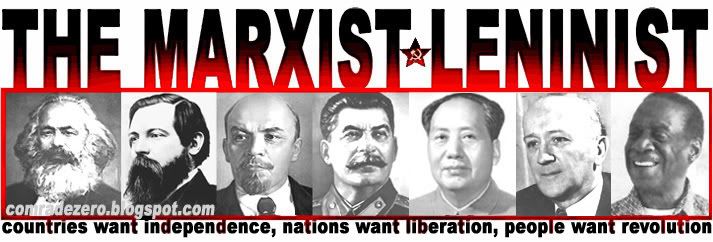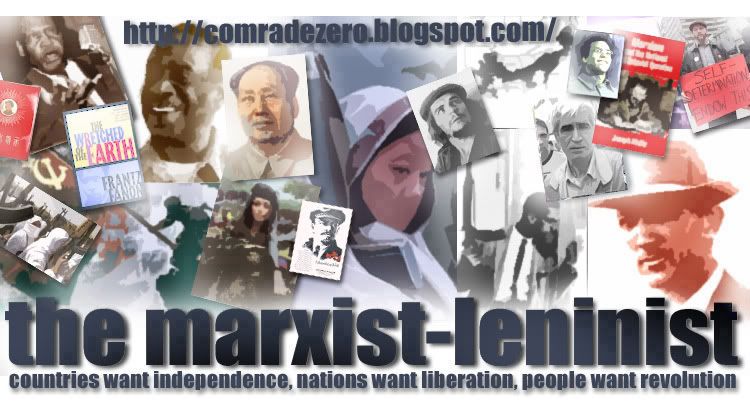Since the 4th of July (Independence Day) is approaching, I thought I would post up the writings of two important communists from the United States, William Z. Foster and Harry Haywood, who have made major contributions to the application of Marxism-Leninism to proletarian revolution in the U.S. The conditions for the proletarian-socialist revolution were set, or at least set in motion to a considerable degree, by the bourgeois-democratic revolution of 1776 and its sequal, the American Civil War and Reconstruction.
Here is what the Communist Party USA founder and leader
William Z. Foster says about the U.S. American Revolution in his
History of the Communist Party of the United States:

'The American Revolution of 1776, which Lenin called one of the "great, really liberating, really revolutionary wars," began the history of the modern capitalist United States. It was fought by a coalition of merchants, planters, small farmers, and white and Negro toilers. It was led chiefly by the merchant capitalists, with the democratic masses doing the decisive fighting. The Revolution, by establishing American national independence, shattered the restrictions placed upon the colonial productive forces by England; it freed the national market and opened the way for a speedy growth of trade and industry; it at least partially broke down the feudal system of tenure; and it brought limited political rights to the small farmers and also the workers, who were mostly artisans, but it did not destroy Negro chattel slavery. And for the embattled Indian peoples the Revolution produced only a still more vigorous effort to strip them of their lands and to destroy them.
'The Revolution also had far-reaching international reprecussions. It helped inspire the people of France to get rid of their feudal tyrants; it stimulated the peoples of Latin America to free themselves from the yoke of Spain and Portugal; and it was an energizing force in the world wherever the bourgeoisie, supported by the democratic masses, were fighting against feudalism. The Revolution was helped to success by the assistance given the rebelling colonies by France, Spain, and Holland, as well as by revolutionary struggles taking place currently in Ireland and England.
'The Revolution was fought under the broad generalizations of the Declaration of Independence, written by Thomas Jefferson, which called for national independence and freedom for all men. It declared the right of revolution and the dominance of the secular over the religious in government. But these principles meant very different things to the several classes that carried through the Revolution. To the merchants they signified their rise to dominant power and an unrestricted opportunity to exploit the rest of the population. To the planters they implied the continuation and extension of their slave system. To the farmers they meant free access to the broad public lands. To the workers they promised universal sufferage, more democratic liberties, and a greater share in the wealth of the new land. And to the oppressed Negroes they brought a new hope of freedom from the misery and sufferings of chattel bondage.

'The Constitution, as orginally formulated in 1787, and as adopted in the face of powerful opposition, constituted primarily the rules and relationships agreed upon by the ruling class for management of the society which they controlled. The Bill of Rights, the first ten amendments of the Constitution, providing for freedom of speech, press, and assembly, religous liberty, trial by jury, and other popular democratic liberties, was written into the Constitution in 1791 under heavy mass pressure.
'Great as were the accomplishments of the Revolution, it nevertheless left unsolved many bourgeois-democratic tasks. These unfinished tasks constituted a serious hendrance to the nation's fullest development. The struggle to solve these questions in a progressive direction made up the main content of the United States history for the three-quarters of a century. Among the more basic of these tasks were the abolition of slavery, the opening up of the broad western lands to settlement, and the deepening extension of the democratic rights of the people. The main post-revolutionary fight of the toiling masses, in the face of fierce reactionary opposition, was aimed chiefly at perserving and extending their democratic rights won by the Revolution.

'It was a great post-revolutionary political rally of these democratic forces that brought Jefferson to the presidency in 1800. Coming to power on a program of wresting the government from the hands of the privileged few, Jefferson sought to create a democracy based primarily upon the small farmers, but excluding the Negroes. From this fact many have drawn the erroneous conclusion that his policies were a brake on American industrial development. Actually, however, by the abolition of slavery in the North, the opening up of public lands, the battle against British "dumping" in America, and the extension of the popular franchise, all during Jefferson's period, the growth of the country's economy was greatly facilitated.
'The extraordinary rapidity of the United States' economic advance in the decades following the victorious revolution was to be ascribed to a combination of several favorable factors, including the presense of vast natural resources, the relative absence of feudal economic and political remnants, the shortage of labor power, the constant flow of immigrants, and the tremendous extent of territory under one government. Another most decisive factor was the immense stretch of new land awaiting capitalist development, the opening up of which played a vital part for decades in the economic and political growth of the country. It absorbed a vast amount of capital; it largely shaped the workers' ideology and also the progress and forms of the labor movement; and it was a main bone of contention between the rival, struggling classes of industrialists and planters. As Lenin, a close student of American agriculture, noted, "The peculiar feature of the United States ... the availability of unoccupied free land" explains "the extremity and wide and rapid development of capitalism in the United States"' (pp. 16-18).
W. Z. Foster also deals with this question in his
Outline History of the World Trade Union Movement:
'With the [Revolutionary] war won, the bourgeoisie typically tried to have the people forget the glowing democratic principles and promises which it had outlined in the Declaration of Independence of 1776. Consequently, at the Constitutional Convention of 1787, which was completely dominated by merchants and planters, the new rulers wrote a constitution that not only left substantially intact the monstrous system of Negro chattel slavery, but also accorded very few civil rights to the white working masses" (p. 98).
Also interesting is what Foster says in his heavy, 600 + page book,
The Negro People in American History. People should reference this text if they can find it because it is very helpful in understanding the realtionship between the African American national quesiton and the American Revolution, as well as how the African American nation develops over time.

The discussion of Emancipation and Reconstruction is also dealt with all of these books by W. Z. Foster. People should also look to the great African American Marxist-Leninist theorist,
Harry Haywood, who discusses it at length in
Black Bolshevik and
Negro Liberation.
Haywood developed the Marxist-Leninist understanding of the African American national question in the U.S. with others in the Comintern, and after revisionism seized the CPUSA, he became a leader of the Communist Party (Marxist-Leninist), an important organization in the pro-Chinese "New Communist Movement". Haywood, following in the footsteps of Lenin and Stalin, argued that African Americans made up an oppressed nation with the right to full equality throughout the United States and the right to self-determination in the Black Belt South, meaning Black people had a right to declare independence themselves if they chose to. The African American national question, now a
central issue of the proletarian-socialist revolution for the multinational working class, was also an important aspect of the bourgeois-democratic revolution in the U.S., and it really came forward as a continuation of the bourgeois-democratic revolution with the
American Civil War between the feudal planter class in the South and the Northern industrialist bourgeoisie.
Here is what Haywood says in
Negro Liberation:
'The Negro was not freed by the Revolution of 1776, nor was he fully freed by the Second American Revolution of 1861-77the Civil War and Reconstruction. The fact is that the first American republic contained a glaring flaw the institution of chattel slavery. This despite the aims so proudly proclaimed by the Declaration of Independence of man's inalienable right to life, liberty, and the pursuit of happiness. Excluded from these "inalienable rights" was an important segment of the American people the Negro slave who, at the time, comprised one-fifth of the country's population.
'Thus, the new American national state created as a result of revolution got off to a false start. This "omission" was to prove almost fatal. The glaring ambiguity of a nation half free and half slave was recognized by the most advanced statesmen of the period, by Paine, Jefferson, Franklin, Samuel Adams, and others.

'It was the belief of the Founding Fathers that slavery would soon die out. Slavery was not particularly profitable, except in a very few areas. The tide of history turned with the industrial revolution in England and the various inventions, topped by the cotton gin, which created a world-wide demand for cotton. In 1789, when the 'Constitution was adopted, no one doubted that there would soon be an end of slavery. By 1818, when the debate began on the admission of Missouri, a new slavocracy had arisen which was demanding expansion into new lands.
'The compromises which the Constitution contained on the issue of slavery precluded the participation of the Negro in the first American republic. It prevented his democratic integration into the new national state. He was thus cheated of the fruits of the victory to which he had contributed in terms of 5,000 of his people in the revolutionary armed forces.
'But the constitutional compromises only postponed the issue of slavery. This issue was to flare up anew in the second decade of the nineteenth century and was to occupy the spotlight in American politics up to the end of the Civil War.
'The question of slavery, as Marx observed, was for half a century the moving power of American history. The issue was finally resolved only by the Second American Revolution - the Civil War and Reconstruction.
'Here again, for the second time, hope was held for the full integration of the Negro into American life as a free and equal citizen, for the consolidation of Americans, black and white, into one nation. But again the revolution was aborted, again the Negro was left outside the portals of full citizenship. The great betrayal of 1877, sealed by the Hayes-Tilden gentlemen's agreement, turned over the management of the South to the new Bourbon classes, who were given the chance to reconstruct that region "in their own way."

'Again the Negro was denied the fruits of the victory, which he had helped to win. Deserted by his erstwhile allies, he was left landless and at the tender mercy of the former slaveholders. Again, as in the Revolution of 1776, he was placed at the doorstep of full freedom only to have the door slammed in his face an unwelcome intruder. This second great defeat blasted his hopes for democratic absorption into American national life.
'But a qualitative change had taken place in his status. Freed from chattel slavery by the uncompleted revolution, he -was now ready for the appearance of economic classes within his group, which under the conditions of segregation and imperialist oppression, necessarily served as driving forces for a movement of national liberation. The process of class stratification among Negroes was of necessity a slow and tortuous one, taking place as it did against the overwhelming odds of post-Reconstruction reaction. But proceed it did, so that the Negroes, who at the time of their release from chattel bondage comprised an almost undifferentiated peasant mass, had by the beginning of the twentieth century become transformed into a people manifesting among themselves the class groupings peculiar to modern capitalist society. Along with an increasing mass of wage laborers, there began to appear a class of small business people, with more or less well-defined capitalist aspirations. This class was to find its spokesmen among the educated middle class. The rise of a Negro bourgeoisie marked the appearance of a class which, striving to defend its own interests under American conditions, was destined to initiate an historical movement, which could only develop in the direction of national freedom. The process of class differentiation developing against the background of Jim-Crow oppression, and in conditions of continued majority concentration of Negroes in the Black Belt, thus formed the main objective conditions for their emergence as an oppressed nation.
'The advent of imperialism, the epoch of the trusts and monopolies, at the turn of the century, riveted the yoke of white ruling-class tyranny still tighter, with the result that the Negro was thrust still further out of the pale of American democracy into deeper isolation within his own group. The rise of a finance-capitalist oligarchy to dominant position in American economic and political life precluded the possibility of peaceful democratic fusion of the Negro into a single American nation along with whites. Thenceforth the issue of Negro equality could be solved only via the path of the Negro's full development as a nation. The Negro question had now definitely become the problem of an oppressed nation striving for national freedom against the main enemy, imperialism' (pp. 141-143).
Harry Haywood also deals with this in his autobiography,
Black Bolshevik:

'The evolution of American Blacks as an oppressed nation was begun in slavery. In the final analysis, however, it was the result of the unfinished bourgeois democratic revolution of the Civil War and the betrayal of Reconstruction through the Hayes-Tilden (Gentlemen’s) Agreement of 1877 . This betrayal was followed by withdrawal of federal troops and the unleashing of counter-revolutionary terror, including the massacre of thousands of Blacks and the overthrow of the Reconstruction governments which had been built on an alliance of Blacks, poor whites and carpetbaggers . The result was that the Black freedmen, deserted by their former Republican allies, were left without land. Their newly won rights were destroyed with the abrogation of the Thirteenth, Fourteenth and Fifteenth Amendments and they were thrust back on the plantations of their former masters in a position but little removed from chattel bondage. The revolution had stopped short of a solution to the crucial land question; there was neither confiscation of the big plantations of the former slaveholding class, nor distribution of the land among Negro freedmen and poor whites. It was around this issue of land for the freedmen that the revolutionary democratic wave of Radical Reconstruction beat in vain and finally broke. The advent of imperialism, the epoch of trusts and monopolies at the turn of the century, froze the Blacks in the post-Reconstruction position; landless semi-slaves in the South. It blocked the road to fusion of Blacks and whites into one nation on the basis of equality and put the final seal on the special oppression of Blacks. The path towards equality and freedom via assimilation was foreclosed by these events, and the struggle for Black equality thenceforth was ultimately bound to take a national revolutionary direction. Under conditions of imperialist and racist oppression, Blacks in the South were to acquire all the attributes of a subject nation. They are set apart by a common ethnic origin, economically interrelated in various classes, united in a common historical experience, reflected in a special culture and psychological makeup. The territory of this subject nation is the Black Belt, an area encompassing the Deep South, which, despite massive outmigrations, still contained (and does to this day) the country’s largest concentration of Blacks' (pp. 231-232).

It is worth noting that
Black Bolshevik contains an important epilogue, in which Harry Haywood looks at the "Black upsurge" of the 1960s and 70s in light of the national question and the role of Marxist-Leninists. That epilogue begins and ends with two quotes from
Mao Zedong:
"The evil system of colonialism and imperialism grew up along with the enslavement of Negroes and the trade in Negroes, and it will surely come to its end with the thorough emancipation of the black people" ("
Statement Supporting the Afro-Americans in Their Just Struggle Against Racial Discrimination by U.S. Imperialism")
And:
"The struggle of the black people in the United States is bound to merge with the American workers' movement, and this will eventually end the criminal rule of the U.S. monopoly capitalist class." ("
Statement by Comrade Mao Tse-tung, Chairman of the Central Committee of the Communist Party of China, in Support of the Afro-American Struggle Against Violent Repression").

Happy Independence Day!
 The great leader of the Chinese Revolution possesses many of the qualities of leadership that characterized Marx, Engels, Lenin, and Stalin. A man of resolution, initiative, and boundless energy, Mao is a brilliant theoretician, an exceptional organizer, and a very powerful leader of the masses in open struggle. These were the qualities that enabled this creative Marxist genius, in the face of prodigious difficulties, to lead the more than half a billion of the Chinese people to decisive victory.
The great leader of the Chinese Revolution possesses many of the qualities of leadership that characterized Marx, Engels, Lenin, and Stalin. A man of resolution, initiative, and boundless energy, Mao is a brilliant theoretician, an exceptional organizer, and a very powerful leader of the masses in open struggle. These were the qualities that enabled this creative Marxist genius, in the face of prodigious difficulties, to lead the more than half a billion of the Chinese people to decisive victory.

















